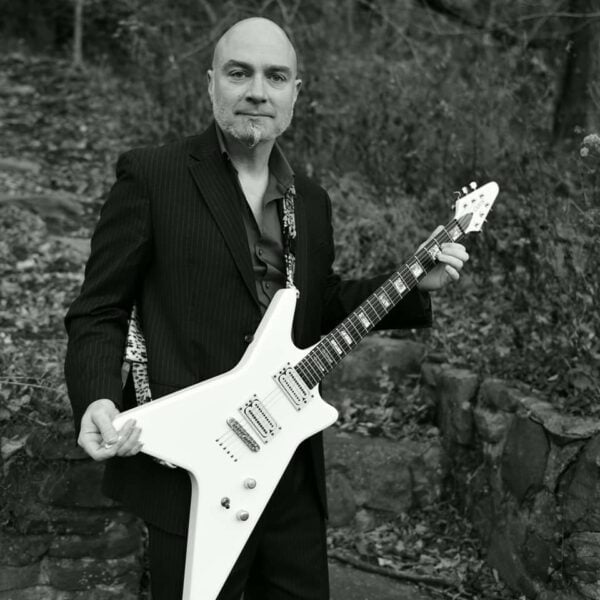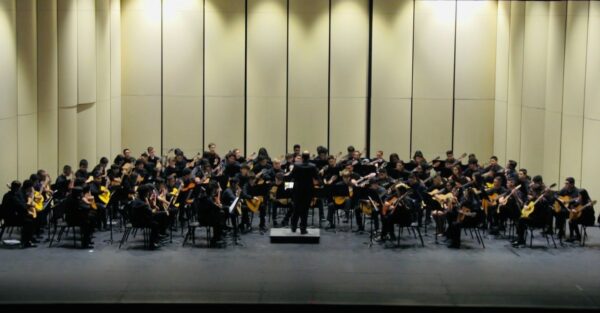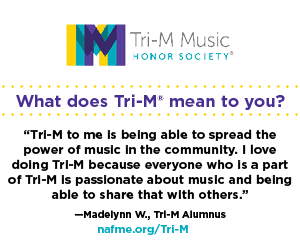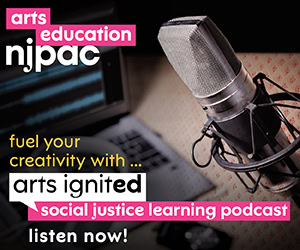/ News Posts / Guitar Class in the Lone Star State
Guitar Class in the Lone Star State
Number 19: The State of Texas
By Thomas Amoriello, Jr
NAfME Council for Guitar Education Chair
Today the NAfME Council for Guitar Education visits Randy Maguire who is currently the Guitar Director at Pebble Hills High School in El Paso, Texas. The mission of the Pebble Hills High School guitar program is to help students reach their full artistic and academic potential.
- Learning will take place in a supportive environment that allows students to develop their skills and perform for their peers and the community.
- Students will have many opportunities to perform and create music at the highest level.
- Students will learn classical guitar technique, which will serve as a foundation for exploring a wide variety of genres.
It is Mr. Maguire’s goal for all students to acquire the skills necessary to learn, perform, and write music, ultimately becoming well-rounded musicians and individuals. This program spans all ability levels, from first-year beginner students, to advanced level students who are ready to continue their studies in college.
Randy is a composer, sound artist, and guitarist originally from El Paso, Texas. Randy creates and performs electroacoustic music, much of which is based in improvisation and also incorporates the use of acoustic instruments. Randy earned a master’s degree in composition at the University of Texas and earned a B.M. in music theory and composition from University of Texas at El Paso (UTEP) in 2008. Various groups have performed his music, including the El Paso Symphony Youth Orchestra, which premiered his orchestral work “Dawn on Mount Franklin.”
Please tell us about your school and overall music program in El Paso.
I teach at Pebble Hills High School which is a part of the Socorro Independent School District in El Paso, Texas. For the last two years, our district has been awarded the NAMM Best Communities for Music Education Award. Our school offers courses in band, orchestra, choir, piano, guitar, and mariachi.
Please tell us about your own personal musical background growing up and your collegiate experience.
I am a native of El Paso, Texas. I started learning music in my school band programs beginning in elementary school and began teaching myself guitar in high school. I had a group of friends who were starting a cover band, and I wanted to be a part of it too, so I started learning. Pretty early on, I also started getting interested in jazz and playing guitar in a jazz combo with some of my other high school friends. It was through the guitar, and specifically using it as a tool to create my own music, that I really fell in love with music and decided this was the path for me.
“It was through the guitar, and specifically using it as a tool to create my own music, that I really fell in love with music and decided this was the path for me.”
I earned a degree in music theory and composition from the University of Texas at El Paso, while studying jazz guitar with Curt Warren. At that time, there was no path to major in music education with guitar as your main instrument. After that, I went to the University of Texas at Austin and got my master’s degree in composition.
What obstacles did you face when you were first hired at your school? Now?
When I was initially hired, my first school did not have a guitar program. I had nothing in the way of resources or materials available to me other than what I owned myself. I was hired only days before the start of the school year, and basically had to invent the curriculum for my program from scratch.
Thankfully, I had the support of the other guitar teachers in my district, who are phenomenal. The cooperation, support, and collaboration that they provided have played a big part in the success of my program.
The perception of what the guitar program is all about is something that has always been a challenge. Because guitar is a more recent addition to our school music programs compared to band or orchestra, there isn’t always a good understanding of what we can do. I think the perception persists that our discipline is somehow not as serious as others, and that it’s basically an easy class where we just “jam.” This is changing, but it is still so critical for guitar directors to promote our programs and the artistic successes that our students achieve.
What kind of classes related to the guitar do you teach?
I am lucky to have a large program of about 165 students, so that translates to a full schedule of guitar classes each day. Beginning next year, I am planning on also teaching an AP Music Theory course.
What would you like to say to the non-guitarist music educator who is about to or interested in incorporating the guitar into their program?
If someone is interested in incorporating the guitar into their program, I would tell them absolutely to do it. Because of the nature of the instrument and its place in our culture, it allows us to reach so many students who may not otherwise participate in their school music program.
“Because of the nature of [guitar] and its place in our culture, it allows us to reach so many students who may not otherwise participate in their school music program.”
For the non-guitarist music educator, I can’t stress enough how important it is to do some research and learn some classical guitar themselves. More than being a good player, it is important to have a firsthand appreciation for good tone and proper technique.
Do you have any success stories you would like to share about students (musical and non-musical)?
Of course, it feels great when you have students who began studying guitar in your class decide to continue on to study music in college. I can think of two former students who are now music majors who weren’t the most naturally gifted players in my program, but they succeeded because they had an amazing work ethic and enthusiasm. I know they will continue to be successful because of those attributes, and it is an honor to have been able to work with them.
Successes come in many different sizes though. I consider it a success when I see former students who are continuing to make music a part of their lives by performing in local rock bands or mariachi groups. I have a special needs student who really struggled with a lot of the physical elements of playing the guitar last year. Even though he is taking the introductory class again, he is now able to keep up with the other students and play the material everyone else is playing. Seeing the look of total pride on his face when he nailed his last playing test, I was just happy to be a part of that.
What do you tell your talented students who are planning to pursue music or guitar studies in college after they finish with you?
I try to be realistic about what studying music entails, because it isn’t easy. The kind of student who should pursue a degree in music is someone who can’t imagine doing something else. When things get difficult, in their studies or later on in their careers, it is the love of the work that has to sustain them.
Sometimes there is a student who absolutely has the desire and ability to be successful in music, but they are discouraged by people who tell them that it isn’t a realistic career path. I try to tell these students that there are really very few “sure things” in any field, but with the right planning and preparation a career in music can be just as viable as a career in another field. Many of the students in our community come from families who have limited financial resources, so it can be challenging to help students find the path forward that is right for them.
Do you have any networking or advocacy tools that have worked for you promoting your program that would help other educators?
For me, the best advocates of my program have been parents, administrators, and the students themselves. This doesn’t happen automatically of course, but it is so important to cultivate those relationships. Probably the most effective way that we do this is through performance. I try to take any opportunity to have my students perform, especially performances for school events and in the community.
What type of lesson plans have you done for your classes that may be unique?
One thing that I have noticed is that many of my students seem to have a reluctance to experiment. They seem to feel more comfortable when all of the musical parameters are already laid out for them. So, we will periodically work on improvising a piece of music together. Usually this connects with our introduction to the style of minimalism. Students are separated into small groups, and each group is responsible for collectively coming up with one short melodic or rhythmic phrase (1-2 measures at most). They may also be assigned some limiting parameters, such as only being able to use a certain set of pitches or a particular rhythmic unit. Usually the limitations will push them to be more creative.
Once each group has its phrase, either I or a student will direct the group, cueing groups to stop or start and experimenting with different layerings of the student phrases. From there we can discuss what they feel worked and what didn’t work, and make changes accordingly. I feel like this activity is also helpful in the early stages of introducing improvisation, as it makes them loosen up and take more ownership over the music creation.
Do you do any musical performance or activities outside of your public school teaching duties?
I have done a lot of performing on guitar as part of the pit orchestra for musicals, and I have played in about twenty different productions. I also work as a composer, most often as part of an arts organization called The Caldo Collective that creates multidisciplinary public art installations.
What kind of future do you see for guitar in music education in Texas school system?
The past ten years have been a period of growth across the state, with more and more schools adding guitar to their offerings. We are working hard to show that our guitar students are capable of just as much success and artistry as students in other disciplines. Currently band, orchestra, and choir in the state of Texas participate in a system through TMEA (Texas Music Educators Association) where their students work hard to be selected as one of the top students in their region, all the way to the state level. It is definitely a long-term goal to have guitar recognized and added to this system.
Band, orchestra, and choir also typically compete each year in a UIL concert and sight-reading contest for large ensembles. In some parts of the state, this event has been approved by UIL for guitar, and it is also a goal for that to be extended to the entire state. Thanks to the hard work or advocacy groups like the Austin Classical Guitar Society, the Texas Guitar Directors Association, and forward-thinking school districts, I think we are gaining momentum.
Past “Guitar Class in 50 States” articles:
- Number 50: The Granite State (New Hampshire)
- Number 49: The Green Mountain State (Vermont)
- Number 48: The Mountain State (West Virginia)
- Number 47: The Hoosier State (Indiana)
- Number 46: The Mount Rushmore State (South Dakota)
- Number 45: The Pine Tree State (Maine)
- Number 44: The Badger State (Wisconsin)
- Number 43: The Constitution State (Connecticut)
- Number 42: The Evergreen State (Washington)
- Number 41: The Pelican State (Louisiana)
- Number 40: The Beaver State (Oregon)
- Number 39: The Equality State (Wyoming)
- Number 38: The Empire State (New York)
- Number 37: The Old Line State (Maryland)
- Number 36: The Centennial State (Colorado)
- Number 35: The Bay State (Massachusetts)
- Number 34: The Sooner State (Oklahoma)
- Number 33: The Prairie State (Illinois)
- Number 32: The Hawkeye State (Iowa)
- Number 31: The Volunteer State (Tennessee)
- Number 30: The Palmetto State (South Carolina)
- Number 29: The Natural State (Arkansas)
- Number 28: The Tar Heel State (North Carolina)
- Number 27: The Magnolia State (Mississippi)
- Number 26: The Peace Garden State (North Dakota)
- Number 25: The Treasure State (Montana)
- Number 24: The First State (Delaware)
- Number 23: The Buckeye State (Ohio)
- Number 22: The Yellowhammer State (Alabama)
- Number 21: The Sunflower State (Kansas)
- Number 20: The Great Lakes State (Michigan)
- Number 18: The Bluegrass State (Kentucky)
- Number 17: The Golden State (California)
- Number 16: The Show-Me State (Missouri)
- Number 15: The Keystone State (Pennsylvania)
- Number 14: The Last Frontier State (Alaska)
- Number 13: The Beehive State (Utah)
- Number 12: The Peach State (Georgia)
- Number 11: The Cornhusker State (Nebraska)
- Number 10: The Gem State (Idaho)
- Number 9: The Old Dominion (Virginia)
- Number 8: The Aloha State (Hawaii)
- Number 7: The Land of Enchantment (New Mexico)
- Number 6: The Sunshine State (Florida)
- Number 5: The Grand Canyon State (Arizona)
- Number 4: The Ocean State (Rhode Island)
- Number 3: The North Star State (Minnesota)
- Number 2: The Silver State (Nevada)
- Number 1: The Garden State (New Jersey)
About the author:
 Thomas Amoriello Jr. serves as the chair on the NAfME Council for Guitar Education and is also the Chairperson for the New Jersey Music Education Association. Tom has taught guitar classes for the Flemington Raritan School District in Flemington, New Jersey, since 2005 and was also an adjunct guitar instructor at Cumberland County College, New Jersey, for five years. He has earned a Master of Music Degree in Classical Guitar Performance from Shenandoah Conservatory and a Bachelor of Arts in Music from Rowan University. He is the author of the children’s picture books A Journey to Guitarland with Maestro Armadillo and Ukulele Sam Strums in the Sand, both available from Black Rose Writing. He recently made a heavy metal recording with a stellar roster of musicians including former members of Black Sabbath, Whitesnake, Ozzy Osbourne, Yngwie J. Malmsteen’s Rising Force, and Dio that was released on H42 Records of Hamburg, Germany. The record released on 12-inch vinyl and digital platforms has received favorable reviews in many European rock magazines and appeared on the 2018 Top 15 Metal Albums list by Los Angeles KNAC Radio (Contributor Dr. Metal). Visit thomasamoriello.com for more information.
Thomas Amoriello Jr. serves as the chair on the NAfME Council for Guitar Education and is also the Chairperson for the New Jersey Music Education Association. Tom has taught guitar classes for the Flemington Raritan School District in Flemington, New Jersey, since 2005 and was also an adjunct guitar instructor at Cumberland County College, New Jersey, for five years. He has earned a Master of Music Degree in Classical Guitar Performance from Shenandoah Conservatory and a Bachelor of Arts in Music from Rowan University. He is the author of the children’s picture books A Journey to Guitarland with Maestro Armadillo and Ukulele Sam Strums in the Sand, both available from Black Rose Writing. He recently made a heavy metal recording with a stellar roster of musicians including former members of Black Sabbath, Whitesnake, Ozzy Osbourne, Yngwie J. Malmsteen’s Rising Force, and Dio that was released on H42 Records of Hamburg, Germany. The record released on 12-inch vinyl and digital platforms has received favorable reviews in many European rock magazines and appeared on the 2018 Top 15 Metal Albums list by Los Angeles KNAC Radio (Contributor Dr. Metal). Visit thomasamoriello.com for more information.
Did this blog spur new ideas for your music program? Share them on Amplify! Interested in reprinting this article? Please review the reprint guidelines.
The National Association for Music Education (NAfME) provides a number of forums for the sharing of information and opinion, including blogs and postings on our website, articles and columns in our magazines and journals, and postings to our Amplify member portal. Unless specifically noted, the views expressed in these media do not necessarily represent the policy or views of the Association, its officers, or its employees.
Catherina Hurlburt, Marketing Communications Manager. June 13, 2019. © National Association for Music Education (NAfME.org)
Published Date
June 13, 2019
Category
- Ensembles
Copyright
June 13, 2019. © National Association for Music Education (NAfME.org)






